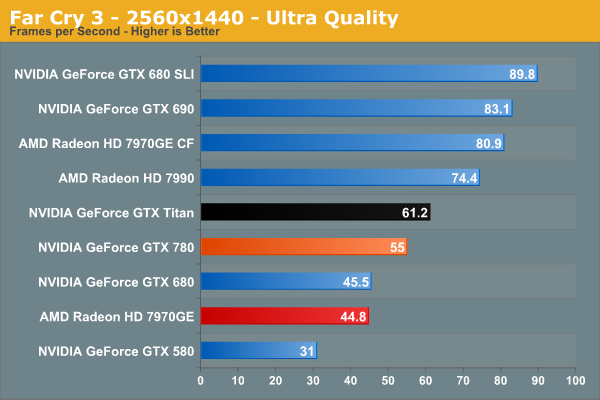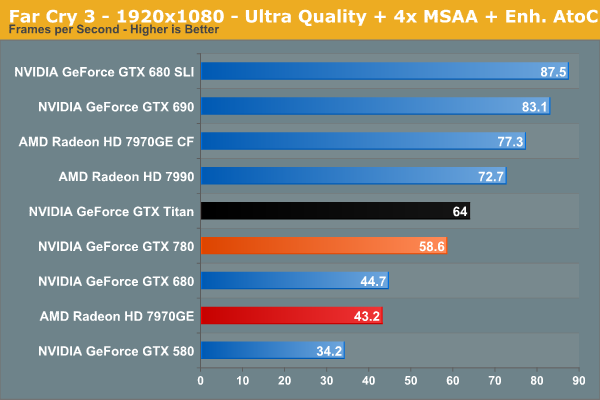NVIDIA GeForce GTX 780 Review: The New High End
by Ryan Smith on May 23, 2013 9:00 AM ESTFar Cry 3
The next game in our benchmark suite is Far Cry 3, Ubisoft’s island-jungle action game. A lot like our other jungle game Crysis, Far Cry 3 can be quite tough on GPUs, especially with MSAA and improved alpha-to-coverage checking thrown into the mix. On the other hand it’s still a bit of a pig on the CPU side, and seemingly inexplicably we’ve found that it doesn’t play well with HyperThreading on our testbed, making this the only game we’ve ever had to disable HT for to maximize our framerates.




Moving on to the back-half of our games, we’re starting to hit the games that traditionally favor NVIDIA’s architectures over AMD’s. Case in point, the GTX 780 has a very solid 23% lead over the 7970GE. Meanwhile the Titan gap is once more around 10%, and this is another Title where the GTX 780 does particularly well relative to the GTX 580, clearing the last generation frontrunner by 77%. Far Cry 3 ends up being an excellent example of where the GTX 780 becomes a filler card; it cleanly fills the gap between the GTX 680 and GTX Titan.










155 Comments
View All Comments
Stuka87 - Thursday, May 23, 2013 - link
The video card does handle the decoding and rendering for the video. Anand has done several tests over the years comparing their video quality. There are definite differences between AMD/nVidia/Intel.JDG1980 - Thursday, May 23, 2013 - link
Yes, the signal is digital, but the drivers often have a bunch of post-processing options which can be applied to the video: deinterlacing, noise reduction, edge enhancement, etc.Both AMD and NVIDIA have some advantages over the other in this area. Either is a decent choice for a HTPC. Of course, no one in their right mind would use a card as power-hungry and expensive as a GTX 780 for a HTPC.
In the case of interlaced content, either the PC or the display device *has* to apply post-processing or else it will look like crap. The rest of the stuff is, IMO, best left turned off unless you are working with really subpar source material.
Dribble - Thursday, May 23, 2013 - link
To both of you above, on DVD yes, not on bluray - there is no interlacing, noise or edges to reduce - bluray decodes to a perfect 1080p picture which you send straight to the TV.All the video card has to do is decode it, which why a $20 bluray player with $5 cable will give you exactly the same picture and sound quality as a $1000 bluray player with $300 cable - as long as TV can take the 1080p input and hifi can handle the HD audio signal.
JDG1980 - Thursday, May 23, 2013 - link
You can do any kind of post-processing you want on a signal, whether it comes from DVD, Blu-Ray, or anything else. A Blu-Ray is less likely to get subjective quality improvements from noise reduction, edge enhancement, etc., but you can still apply these processes in the video driver if you want to.The video quality of Blu-Ray is very good, but not "perfect". Like all modern video formats, it uses lossy encoding. A maximum bit rate of 40 Mbps makes artifacts far less common than with DVDs, but they can still happen in a fast-motion scene - especially if the encoders were trying to fit a lot of content on a single layer disc.
Most Blu-Ray content is progressive scan at film rates (1080p23.976) but interlaced 1080i is a legal Blu-Ray resolution. I believe some variants of the "Planet Earth" box set use it. So Blu-Ray playback devices still need to know how to deinterlace (assuming they're not going to delegate that task to the display).
Dribble - Thursday, May 23, 2013 - link
I admit it's possible to post process but you wouldn't, a real time post process is highly unlikely to add anything good to the picture - fancy bluray players don't post process, they just pass on the signal. As for 1080i that's a very unusual case for bluray, but as it's just the standard HD TV resolution again pass it to the TV - it'll de-interlace it just like it does all the 1080i coming from your cable/satelight box.Galidou - Sunday, May 26, 2013 - link
''All the video card has to do is decode it, which why a $20 bluray player with $5 cable will give you exactly the same picture and sound quality as a $1000 bluray player with $300 cable - as long as TV can take the 1080p input and hifi can handle the HD audio signal.''I'm an audiophile and a professionnal when it comes to hi-end home theater, I myself built tons of HT system around PCs and or receivers and I have to admit this is the funniest crap I've had to read. I'd just like to know how many blu-ray players you've personnally compared up to let's say the OPPO BDP -105(I've dealt with pricier units than this mere 1200$ but still awesome Blu-ray player).
While I can certainly say that image quality not affected by much, the audio on the other side sees DRASTIC improvements. Hardware not having an effect on sound would be like saying: there's no difference between a 200$ and a 5000$ integrated amplifier/receiver, pure non sense.
''the same picture and sound quality''
The part speaking about sound quality should really be removed from your comment as it really astound me to think you can beleive what you said is true.
eddman - Thursday, May 23, 2013 - link
http://i.imgur.com/d7oOj7d.jpgEzioAs - Thursday, May 23, 2013 - link
If I were a Titan owner (and I actually purchase the card, not some free giveaway or something), I would regret that purchase very, very badly. $650 is still a very high price for the normal GTX x80 cards but it makes the Titan basically a product with incredibly bad pricing (not that we don't know that already). Still, I'm no Titan owner, so what do I know...On the other hand, when I look at the graphs, I think the HD7970 is an even better card than ever despite it being 1.5 years older. However, as Ryan pointed out for previous GTX500 users who plan on sticking with Nvidia and are considering high end cards like this, it may not be a bad card at all since there are situations (most of the time) where the performance improvements are about twice the GTX580.
JeffFlanagan - Thursday, May 23, 2013 - link
I think $350 is almost pocket-change to someone who will drop $1000 on a video card. $1K is way out of line with what high-quality consumer video cards go for in recent years, so you have to be someone who spends to say they spent, or someone mining one of the bitcoin alternatives in which case getting the card months earlier is a big benefit.mlambert890 - Thursday, May 23, 2013 - link
I have 3 Titans and don't regret them at all. While I wouldn't say $350 is "pocket change" (or in this case $1050 since its x3), it also is a price Im willing to pay for twice the VRAM and more perf. With performance at this level "close" doesn't count honestly if you are looking for the *highest* performance possible. Gaming in 3D surround even 3xTitan actually *still* isn't fast enough, so no way I'd have been happy with 3x780s for $1000 less.